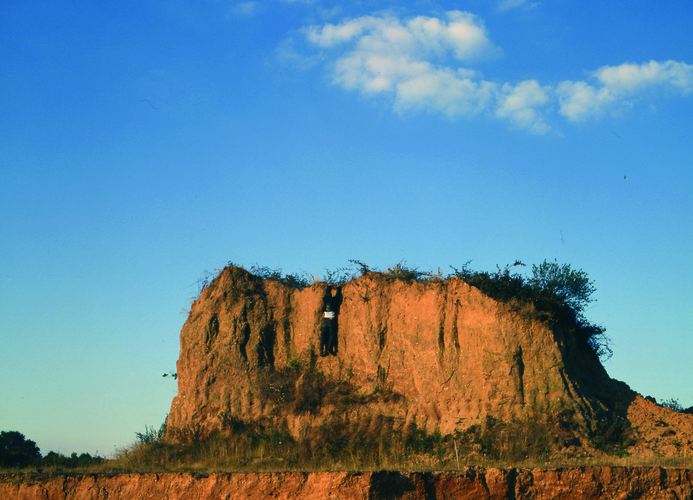
Expositions
04 Avril - 13 Juillet 2007
L'île de Morel
Avec Sabine Hornig, Daniel Malhão, Jean-Luc Moulène, Manuela Marques, Paul Pouvreau, Evariste Richer
La photographie, comme les miroirs et les échos, dédouble le réel en le répétant pendant une certaine durée. Ce qui les différencie, c'est l'enregistrement de cette répétition sous forme d'image et la manipulation du désir qui y est inhérente. Vivant dans un monde d'images, nous avons accepté de renoncer au volume, à la gravité, à la dimension, au mouvement, au temps, au profit d'une image photographique. Nous troquons la possibilité d'interagir contre la contemplation. L'écrivain argentin A. Bioy Casarès pousse ce troc diabolique à son paroxysme en créant un mythe de Pygmalion inversé dans lequel un homme, par amour compulsif, devient image à l'aide de l'invention de Morel. L'espace du CPIF deviendrait cette île : le lieu où la possibilité d'enregistrer et de projeter des images est présentée non seulement sous le signe du dédoublement, mais aussi de l'inversion et du désir pulsionnel d'une fiction.
En effet, l'image enregistrée inverse notre rapport au monde, comme si l'alphabet hallucinatoire des sensations se matérialisait et anticipait sa formation. C'est justement ainsi que se produit un va et vient entre les individus, les corps, les choses, par des glissements dans d'autres dimensions (comme celle du langage, de la physique, du cinéma, de l'architecture, voir même de celle où le spectateur se trouve, l'espace de la perception de l'oeuvre). Reprises, inversions temporelles, mises en situation du corps du spectateur ou virtualisation de son propre devenir-image, sont à l'oeuvre aussi bien dans les travaux photographiques et sculpturaux présentés.
Dans l'optique de ce dédoublement de la sphère de l'expérience en son image, il y aura un deuxième volet. Certaines oeuvres changeront suivant l'évolution de la vie sur l'île de Morel.
Joana Neves.
Cette exposition s'inscrit dans le projet Hospitalité.
Like mirrors and echoes, photography duplicates the real by repeating it during a certain lapse of time. Photography differentiates itself by recording this repetition as an image and the inherent manipulation of desire. Living in a world filled with images, we have agreed to give up on volume, gravity, dimension, movement, and time - for the sake of photographic images. We have traded the possibility of interaction for the gaze. The Argentinean writer A. Bioy Casarès pushes this diabolical transaction to its paroxysm by creating an inverted Pygmalion myth in which a man, out of compulsive love, turns himself into an image with the help of Morel's Invention, on a faraway island. The space of the CPIF becomes this island: a place where the possibility of recording and projecting images is presented not only as split reality, but also as an inversion and a driven desire for fiction.
Since the recorded image inverts our relation to the world, as if the hallucinatory alphabet of sensations materialised and anticipated its formation. That is exactly how this continual exchange between individuals, bodies, and things happens, through shifts into other dimensions (like language, physics, cinema, architecture, the work's space of perception, even the one where the viewer stands). Repetition, time inversion, the location of the viewer's body or the virtualization of himself as an image are at work not only in the photographic pieces but also in the sculptures and installations presented.
The works thus invest the space inside as well as what lies outside the photo: in The Destroyed Room by Sabine Hornig, the photograph serves as a scaffold whereas the real space becomes fictional. Other interventions sculpt the space by giving it an absent geometry while questioning the viewer's role as in Télé by Paul Pouvreau or La Guérite by Jean-Luc Moulène, which emphasizes the presence of the spectator's aura in the standing position. Daniel Malhão and Evariste Richer both propose work where the gaze slides by on a neutral surface or rather bounces towards another time space. La Mer by Manuela Marques flows before one's eyes, contrary to the expected immensity that the seaborne elements induce an oppressive sensation of a surface hiding troubled depths. As simple as it seems, this video reveals the power of any photographic image, in between depth and surface.
In regard to this unfolding of the field of experience into its image, there will be a second part of the show. Certain works will change with the evolution of life in Morel's island.
